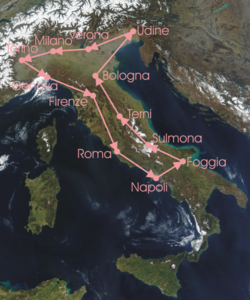Top Qs
Timeline
Chat
Perspective
1926 Giro d'Italia
Cycling race From Wikipedia, the free encyclopedia
Remove ads
The 1926 Giro d'Italia was the 14th edition of the Giro d'Italia, a Grand Tour organized and sponsored by the newspaper La Gazzetta dello Sport. The race began on 15 May in Milan with a stage that stretched 275 km (171 mi) to Turin, finishing back in Milan on 6 June after a 288 km (179 mi) stage and a total distance covered of 3,249.7 km (2,019 mi). The race was won by the Giovanni Brunero of the Legnano team. Second and third respectively were the Italian riders Alfredo Binda and Arturo Bresciani.[1][2][3][4][5][6]
Remove ads
Participants
In the two previous editions, a conflict between cycling teams and the Giro organisation had the effect that all riders rode as individuals, and that some teams kept their riders away from these Giros. In 1926, this conflict had been resolved and the teams were back, but they had to allow the Giro to increaes the number of participants considerably.[7]
Of the 206 riders that began the Giro d'Italia on 15 May, 40 of them made it to the finish in Milan on 6 June. Riders were allowed to ride on their own or as a member of a team. There were six teams that competed in the race: Berrenttini, Ganna, Legnano, Météore, Olympia, and Wolsit.[8] Eighteen of the 206 riders were on a team.[8]
The peloton was primarily composed of Italians.[8] The field featured two former Giro d'Italia champions in two-time winners Costante Girardengo and Giovanni Brunero, 1924 winner Giuseppe Enrici, and returning champion Alfredo Binda.[8] Other notable Italian riders that started the race included Giovanni Rossignoli and Angelo Gremo.[8]
Remove ads
Race summary
Summarize
Perspective
In the first stage, Binda crashed. A mechanical failure costed him a lot of time, and he finished more than twenty minutes behind his rival Girardengo.[8]
That first stage was won by Piemontesi, who also won the second stage. Piemontesi had a firm lead in the general classification.[8]
Binda won back some time by winning the third stage, but he was still far behind in the general classification. His team mate Brunero was doing much better, and Binda decided to ride in support of Brunero. In the fourth stage, Binda and Brunero escaped together with Girardengo; all other riders lost over ten minutes to them. Girardengo became the new leader, with Brunero close behind him.[8]
In the fifth and the sixth stage the three riders finished in front of the field; Girardengo won the fifth stage, and Binda won the sixth. Thus, Girardengo led after the sixth stage. In the subsequent rest day, he became sick. He started the seventh stage, but had to abandon in the first half.[9] Binda and Brunero rode away from the other riders, and won with a margin of more than 25 minutes. Brunero became the new leader of the general classification; Binda was in third place, and would have been leading if the time loss in the first stage would not have happened.[8]
Brunero did not get into problems in the final stages, and neither did Binda; Binda won three more stages, and jumped to second place in the general classification when Bresciani lost time. Therefore Brunero became the winnre of the 1926 Giro, with his team mate Binda in second place.[8]
Remove ads
Final standings
Summarize
Perspective
Stage results
General classification
There were 40 cyclists who had completed all twelve stages. For these cyclists, the times they had needed in each stage was added up for the general classification. For the first time, there was a time bonus for stage winners: the winner of a stage had 1:30 subtracted from their time.[10] The cyclist with the least accumulated time was the winner. Giuseppe Enrici won the prize for best ranked independent rider in the general classification.[11]
Remove ads
Notes
- In 1926, there was no distinction in the rules between plain stages and mountain stages; the icons shown here indicate that the first, third, fourth, sixth, seventh, eighth, eleventh, and twelfth stages included major mountains.
References
Wikiwand - on
Seamless Wikipedia browsing. On steroids.
Remove ads

